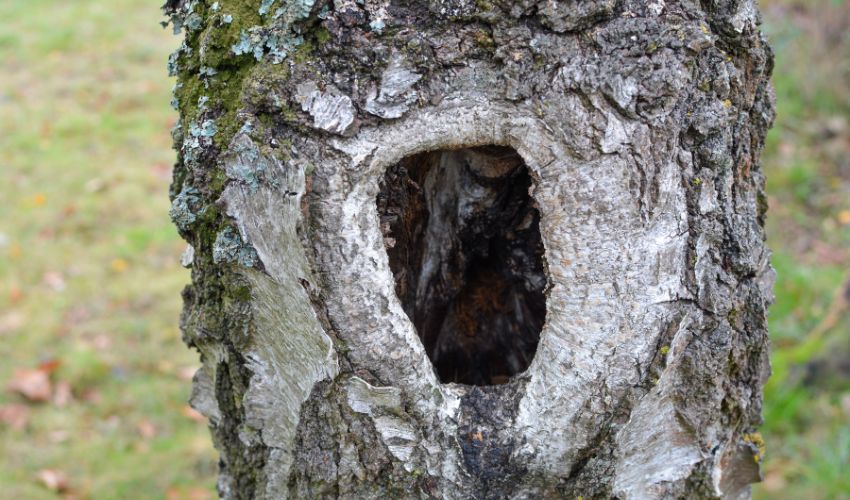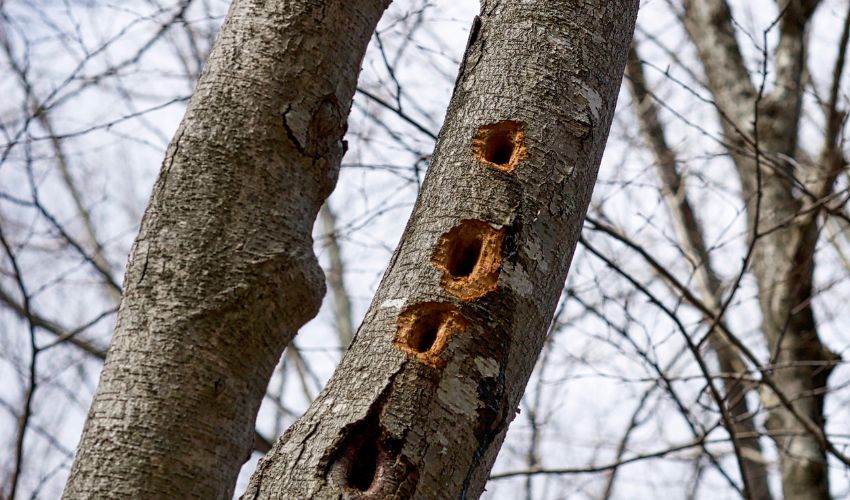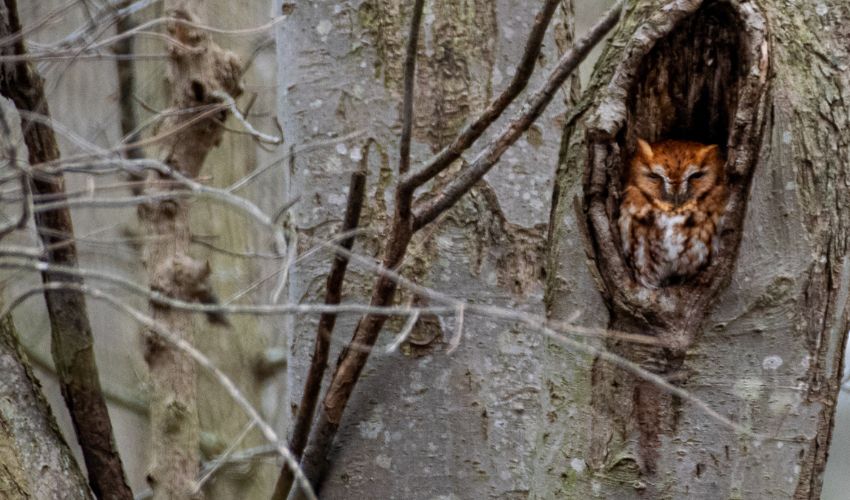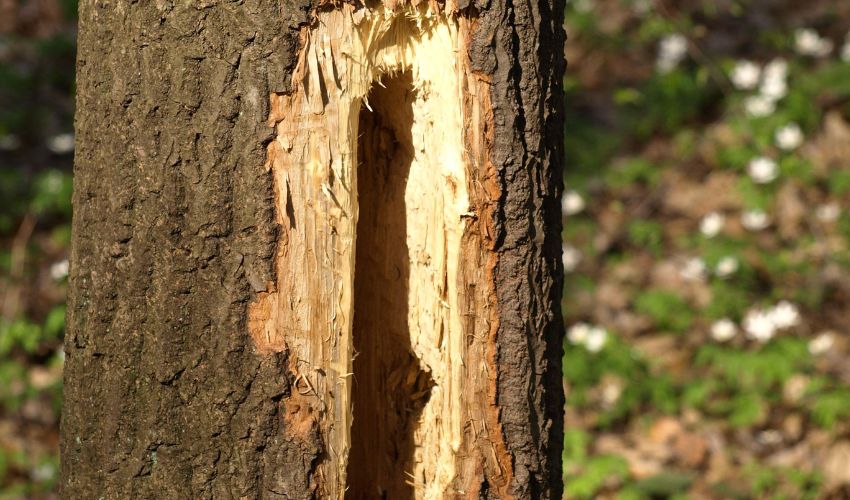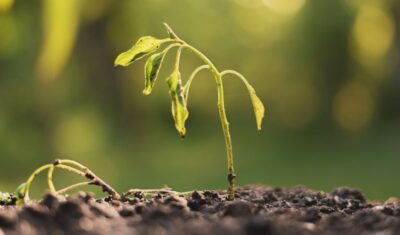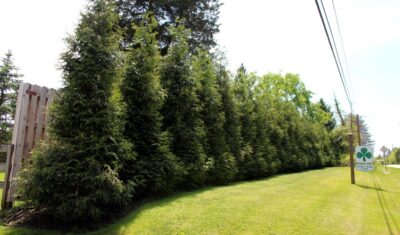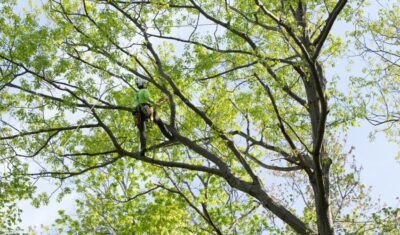Holes or cavities in trees are a normal occurrence, but many property owners in Ohio ask us if anything should be done about them. The short answer? No, leave the cavities alone.
Cavities are a natural part of many trees’ lives, and while some wounds may impact a tree’s health, any attempts to fill or drain the cavities can cause more damage to the tree.
In this article, we’ll go over how cavities form, what to do (and what not to do) if your tree becomes wounded, and how you can improve the overall health of a tree with a cavity.
Where do tree cavities come from?
A tree hole, or cavity, is formed from the tree becoming damaged in some way. Just as how our bodies form a scab when our skin is broken, a tree will create a barrier between any wounds and openings with a thick internal layer of cells.
How does a tree become damaged in the first place? There are many opportunities for a tree to receive a wound, including:
Improper Pruning
When pruning cuts are not done correctly, they can leave open wounds that encourage pests and diseases to enter the tree. Proper pruning includes using the correct tools, pruning at the right location of a branch, not over-pruning, and more.
One of the worst cases of improper pruning is when a tree is topped. This tree pruning method goes by many names but refers to the top of a tree being cut off. Tree topping stresses trees and leads to more problems as the tree puts out weak branches to try to produce leaves for photosynthesis.
Topping a tree is one of the most common ways a tree can become injured through improper pruning, but is not the only way.
Learn more about proper tree pruning >>
Mechanical Injury
When a lawnmower runs over tree roots, that can cause injury. Trimmers, vehicles, and other equipment can also cause damage to tree bark or even rip sections of it off, which leads to tree wounds.
Animals can injure trees. Deer like to rub their antlers on tree bark, woodpeckers can create tree cavities or holes to get to insects inside trees, and carpenter ants will create tunnels through trees.
Other instances of tree injury can include when people intentionally carve into tree bark, when the bark is peeled off (either purposefully or unintentionally), or various other cases where trees incur cuts, wounds, or lost bark.
Learn how to protect trees during construction, a time when many tree injuries occur.
Storm Damage
Storms and inclement weather are the final ways in which trees are often injured, leading to cavities.
Lightning damages a tree quickly, causing the bark to be ripped off and a wound to form in the interior of the tree.
Strong winds can cause broken branches and can tear off the bark. Trees can split when the temperature changes rapidly (called frost cracks).
What Should You Do If Your Tree Has a Cavity?
Once you notice a hole in your tree, the inclination may be to do something. However, most often the best thing you can do is leave it be.
Do Let the Tree Seal Off the Wound
The amazing thing about trees is that they can deal with the holes themselves. As long as the tree is generally healthy, well-watered, and receiving enough nutrients, it can compartmentalize the section of the tree that is injured, creating a barrier between the cavity and the rest of the tree.
The primary defense of the tree against decay is compartmentalization. Trees can seal off the damaged parts, blocking access to the rest of the tree. That way, if decay gets into the injured part of the tree, it can’t move through the tubes that carry water and nutrients into other parts of the tree.
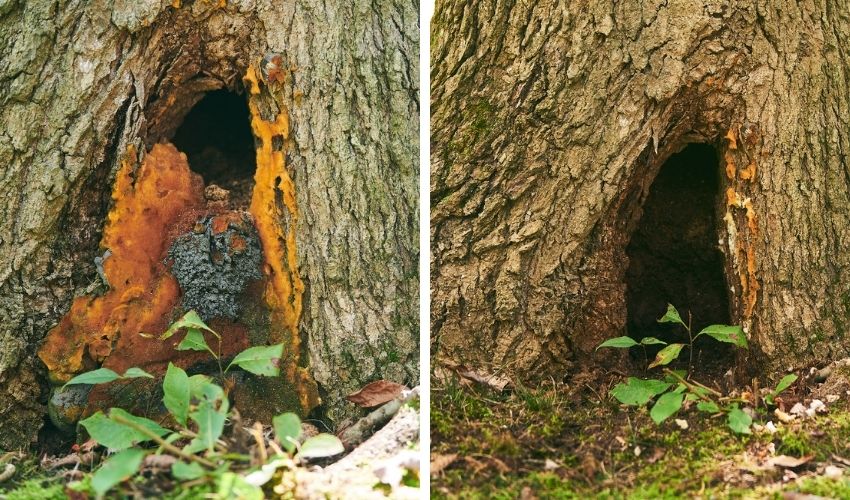
Spray foam was used by a property owner (left image) in an attempt to seal up this tree wound. Independent Tree does not recommend the use of spray foam and it was removed and the wound cleaned (right image)
Do Not Fill the Cavity
At one point, tree cavities were filled with various materials in an attempt to “fill” the hole. Cement was one of the common materials used. However, cement does not allow the tree to bend and move naturally and therefore contributes to further damage to the tree.
We’ve also seen spray foam applied to tree wounds, but that does more harm than good as well. Some property owners would fill the hole with rocks, leaves, sticks, or other materials, which don’t help the tree either.
Adding any type of material to the inside of a tree increases the moisture, which leads to decay, which you want to avoid to keep your tree healthy and strong.
As a general rule, avoid putting anything into a tree wound or cavity.
Do Not Empty or Drain the Cavity
Another “treatment” method employed in the past was to empty the cavity. The cavities can become filled with water when exposed to enough rainfall.
The method that was usually employed to remove the water was to drill a hole. However, any additional wound causes more damage to the protective walls of the tree, leading to further decay. It also allows fungi to enter the tree, adding to the issues the tree is fighting off.
Any standing water can become a breeding ground for mosquitoes. If you’re noticing more mosquitoes on your property and think the problem may be coming from the water inside a tree cavity, you can add some mosquito dunks that will kill any mosquito larvae in the water.
Do Enjoy Seeing Wildlife in the Cavity
Nature takes advantage of these holes in trees. Wildlife will be grateful for a place to hide from the elements, build a nest, or rest for a while.
One added benefit of a tree cavity is that when there are places like that for wildlife creatures to rest, there are fewer animals in places like attics and garages!
Do Maintain the Health of Your Tree
The best thing you can do for a tree with an open wound or cavity (other than leaving the hole alone) is to keep the tree as healthy as possible. Ensure it receives the correct amount of water, keep it fertilized when needed, schedule regular maintenance pruning, and check for any pests or issues that may need to be treated.
Maintaining the health of your tree gives it the energy to deal with the wound on its own and makes it less susceptible to any additional stressors.
Does a Tree Cavity Mean My Tree is Decaying?
Sometimes, yes. If a cavity is large enough, it can lead to tree decay. When a tree is wounded, it doesn’t “heal”; instead, the tree seals off the wounded part. However, if the wound is too big, the tree can end up killing itself by sealing it off and massively restricting its nutrient and water flow.
Similarly, if the wound or decay is in the main tree trunk, the tree may not be able to seal it off without killing the upper parts of the tree. In those cases, it will be almost impossible to stop the spread of decay.
The Independent Tree team can test this by using a resistograph to measure how much decay your tree has. Based on the results of this test, we may recommend removing the tree before it decays further. Decaying trees can often become unstable and weak and are more likely to fall or break in inclement weather.
Contact Independent Tree for a Tree Assessment
Decay management, growth regulators, and deep root fertilization are all services we perform that can help maintain tree health and slow the decay process.
If you notice a wound or cavity on any of your trees, contact Independent Tree to schedule a tree assessment with one of our arborists. We can help you determine the level of decay in your tree, advise you on ways to keep your tree healthier, and assist in getting and keeping all of your trees and shrubs beautiful and well-maintained.
Contact us today for more information on any of our tree health services.
Do Your Trees Have Cavities?
If your worried that any holes in your trees may be leading to decay, schedule an assessment with Independent Tree.Recent Articles
Topics
About The Author

STAY IN THE LOOP
WITH OUR
LATEST UPDATES
"*" indicates required fields

